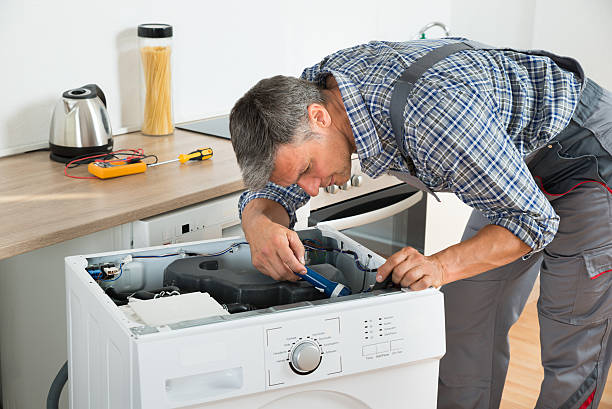Washing machines quietly perform their daily chore, but have you ever wondered about the hidden mechanics behind their soothing hum? One intriguing mystery is: Do washing machines have transmissions?
This enigmatic component, often associated with cars, might not seem relevant in the laundry room, but its presence could hold the key to efficiency and performance.
To unveil the truth, you must delve deeper into the inner workings of these household appliances!
Do Washing Machines Have Transmissions?
Yes, most washing machines have transmissions. The transmission helps to spin the drum faster, which is what helps to clean the clothes.
In a washing machine, the transmission is responsible for controlling the agitator or drum’s movement during the wash and spin cycles. It helps regulate the speed and direction of rotation.
However, this washing machine transmission is not a complex mechanical gearbox with multiple gears like you would find in a car. Instead, it typically consists of a simple set of gears, pulleys, and belts or a direct-drive motor system to achieve the necessary movements.
The primary purpose of this transmission or gearbox in a washing machine is to ensure that the agitator or drum rotates at the appropriate speeds and in the right direction to facilitate the washing and rinsing process.

Types of Washing Machine Transmissions
Washing machines come in different types and models, and one of the factors that differentiate them is the type of transmission they use. There are two main types of transmissions used in washing machines: belt-driven transmissions and direct-drive transmissions.
Let’s explore each type and discuss their advantages and disadvantages:
Belt-driven transmissions
Advantages
- Cost-Effective: Belt-driven transmissions are generally more cost-effective to manufacture and repair. This can lead to lower initial purchase prices and potentially lower repair costs for consumers.
- Vibration Dampening: The belt acts as a buffer between the motor and the drum, which helps dampen vibrations during operation. This can result in quieter and smoother washing cycles.
- Flexibility: Belt-driven systems allow for more flexible placement of the motor and transmission components, making it easier for manufacturers to design and assemble washing machines.
Disadvantages
- Maintenance Required: Belts can wear out over time and may need periodic replacement. This adds a maintenance task and costs for the owner.
- Efficiency: Belt-driven transmissions may be slightly less energy-efficient than direct-drive systems due to energy losses in the belt.
- Limited Speed Control: Achieving precise speed control in belt-driven systems can be challenging, which may affect washing performance in some models.
Direct-drive transmissions
Advantages
- Efficiency: Direct-drive transmissions are highly efficient because they eliminate energy losses associated with belts and pulleys. This can result in lower energy consumption and reduced operating costs over time.
- Durability: With fewer moving parts, direct-drive systems are often more durable and have a longer lifespan. They are less prone to belt wear and related maintenance issues.
- Precise Speed Control: Direct-drive systems offer precise control over the drum’s speed and direction, allowing for more advanced washing cycles and better performance.
Disadvantages
- Higher Initial Cost: Washing machines with direct-drive transmissions tend to be more expensive upfront due to the advanced technology and manufacturing processes involved.
- Vibration: While direct-drive systems can be designed to minimize vibration, they may be more prone to transmitting vibrations from the motor to the drum, potentially leading to slightly noisier operation.
- Complex Repairs: If a direct-drive transmission does require repair, it can be more complex and costly due to the integrated design.
How Does a Washing Machine Transmission Work?
A washing machine transmission is responsible for transferring power from the motor to the drive system. It is a vital component of your washer and consists of several parts, including gears, pulleys, and a belt.
The transmission helps to rotate the drum during the wash cycle and also controls the speed at which the drum spins.
If there is an issue with your washer’s transmission, it can cause problems with the machine’s performance.
Also read: Do I Need A Drip Pan Under My Washing Machine?
How Do You Check a Washing Machine Transmission?
The best way to check a washing machine transmission is to remove the access panel and visually inspect the transmission.
If it looks corroded or damaged, it will need to be replaced. If the problem is not visibly obvious, you can use a multimeter to test the continuity of the winding. To do this, disconnect the washing machine from power and remove the access panel.
How Do You Know If Your Washer Needs a Motor Transmission or Clutch?
One way to check if your washer needs a motor transmission or clutch is to simply open up the washer and look for any signs of damage.
If you see any frayed or broken wires, damaged belts, or leaking fluids, then it is most likely that the washer will need a new motor transmission or clutch. Another way to check is to listen to the washer while it is running.
If you hear any strange noises coming from the washer, it is also a sign that it may need a new motor transmission or clutch.
The best way to be sure though is to consult with a trained professional who can diagnose the problem and recommend the best course of action.
Conclusion
This is the very end of this comprehensive article. So, do washing machines have transmissions?
Washing machines indeed have transmissions. These specialized components, which can be belt-driven or direct-drive, play a crucial role in regulating the drum’s movement during washing and spinning cycles.
While both transmission types have their advantages and disadvantages, choosing the right one depends on factors like cost, durability, and energy efficiency, allowing consumers to make informed decisions when selecting a washing machine to meet their specific needs.







